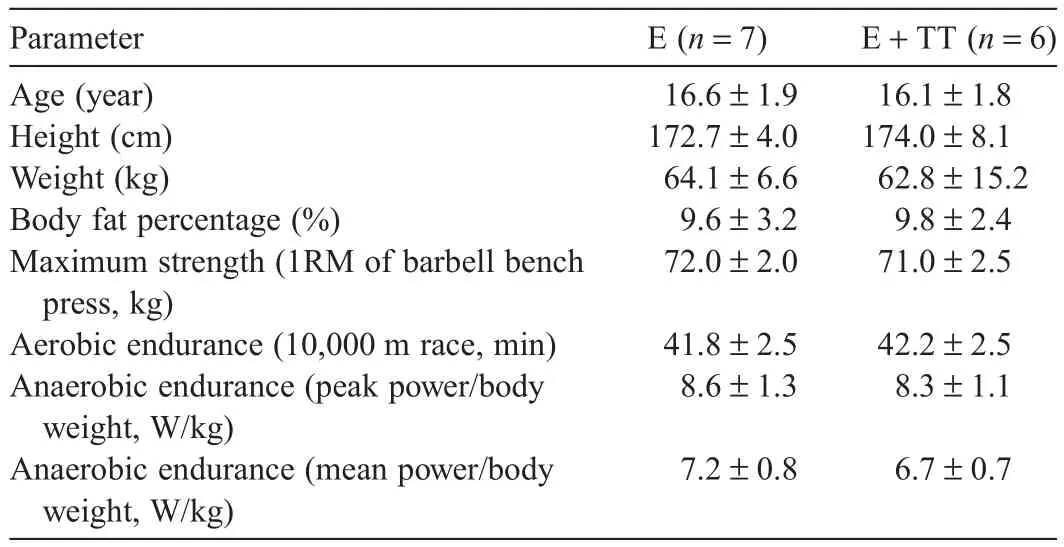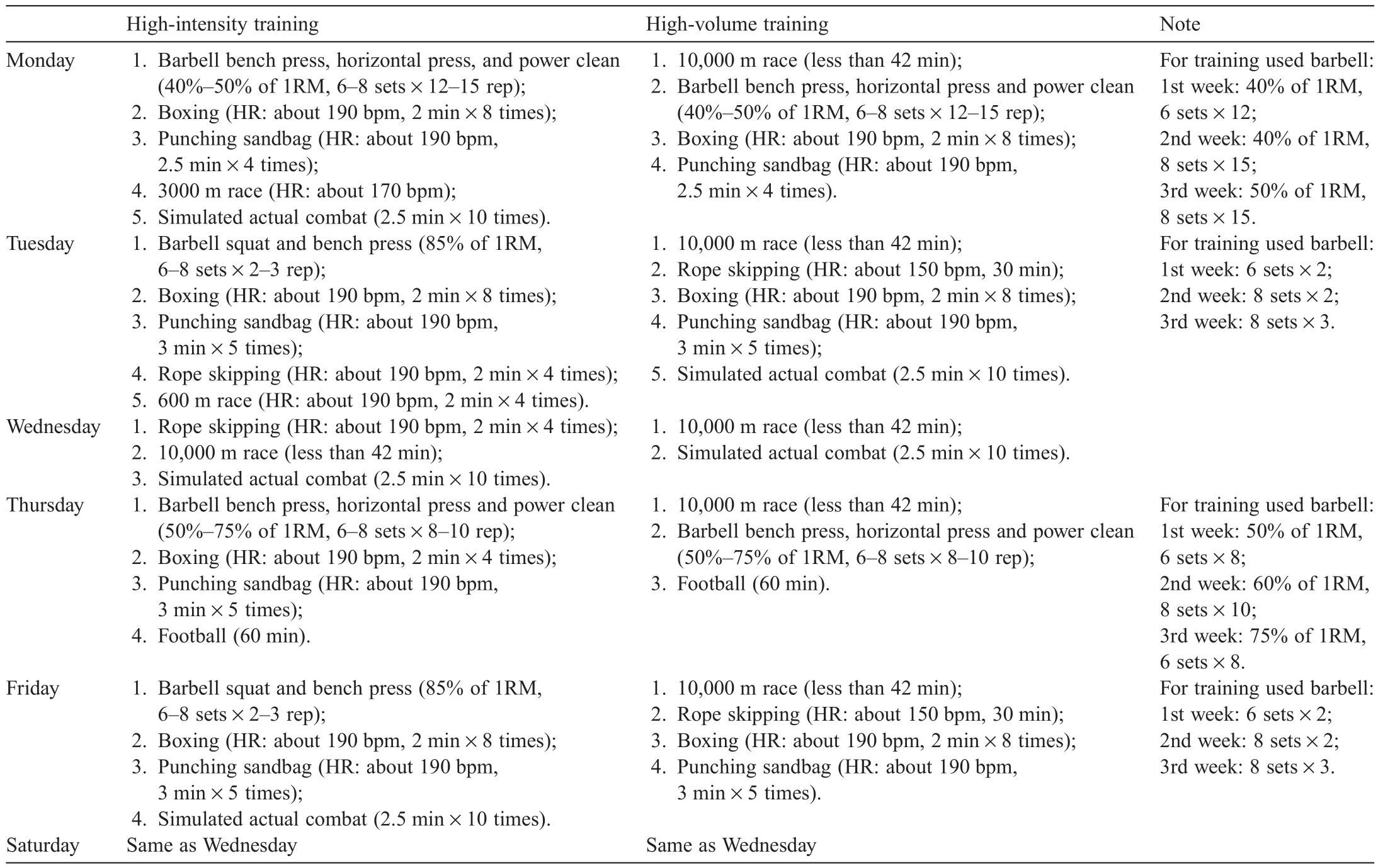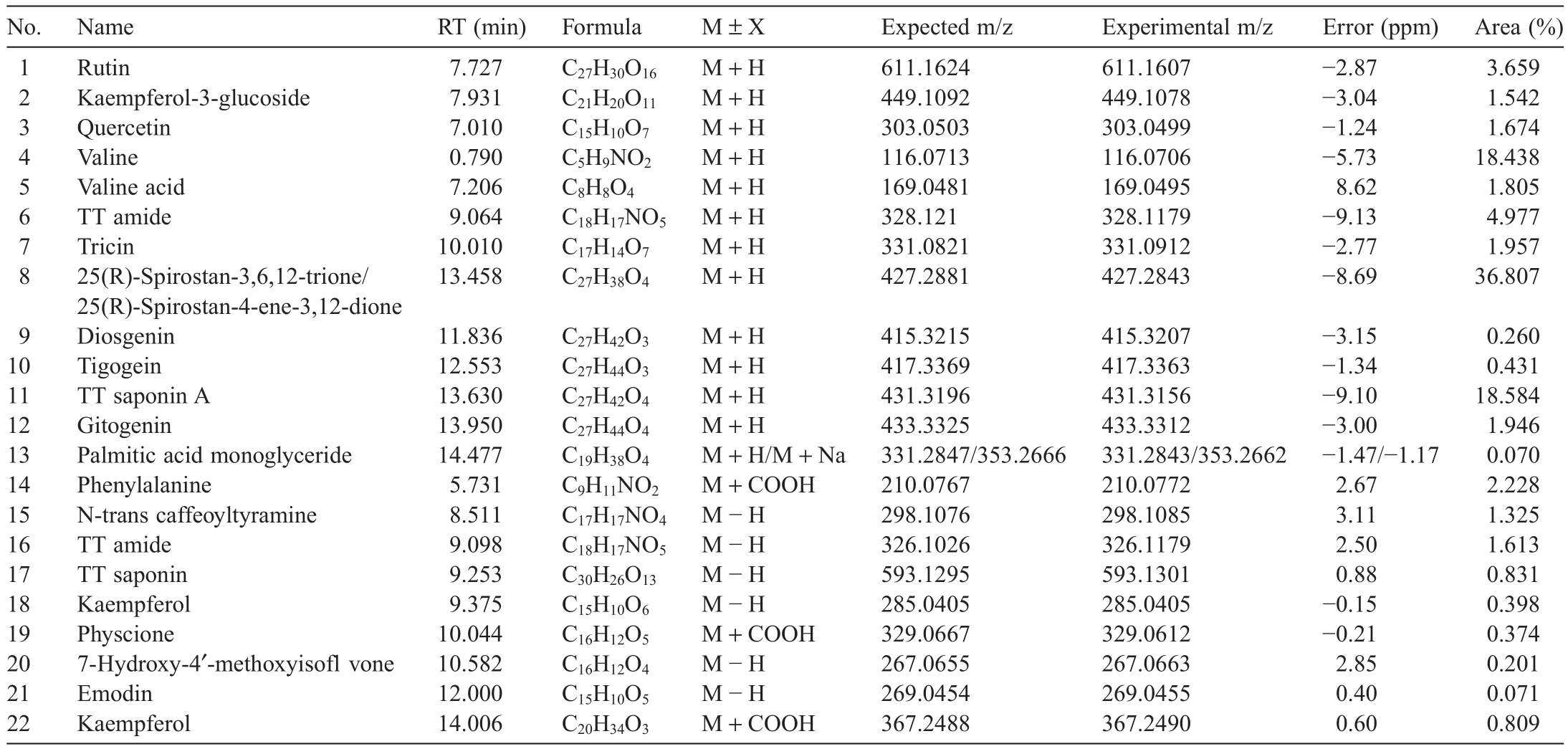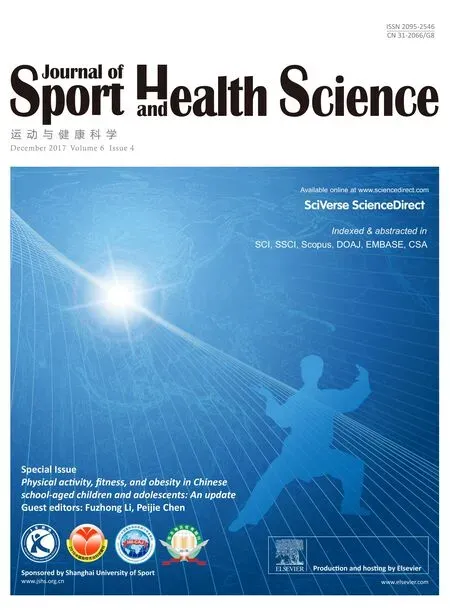Tribulus terrestris extracts alleviate muscle damage and promote anaerobic performance of trained male boxers and its mechanisms:Roles of androgen,IGF-1,and IGF binding protein-3
2018-01-08YimingMaZhichengGuoXiaohuiWang
Yiming Ma,Zhicheng Guo,Xiaohui Wang*
School of Kinesiology,Shanghai University of Sport,Shanghai200438,China
1.Introduction
Tribulus terrestris(TT)is a famous traditional Chinese medicine that has been widely used in many countries for thousands of years.1TT revealed many compounds including steroidal saponins,fl vonoids,alkaloids,and amino acids.TT saponins are considered the most important active components that possess a broad range of biological effects such as relieving sexual dysfunction and improving erectile function in rabbits and males,2protecting myocardium against ischemia/reperfusion injury and treating hypertension and coronary heart disease.3
TT,claimed to be a testosterone booster,is a popular nutritional supplement in athletes and physically active men for enhancing gain in muscle mass,strength,and performance.Supplement of TT extracts increased serum testosterone levels on male rats,4–7primates,rabbits and castrated rats.8Our previous studies demonstrated that TT extracts improved exercise performance of rats with high-intensity endurance training9and overload training10by increasing plasma level of testosterone.However,different views still exist.TT has no significan influence on serum testosterone concentrations,strength,lean body mass,and exercise performance in elite rugby league players,11resistance-trained males,12and normal females13,14as well as intact and castrated rats.13,14Although there is little strong evidence to prove that TT truly has the effects of testosterone booster and muscles anabolism promoter,3TT extracts are still used constantly by many athletes.More clinical trials should be carried out to get a clear conclusion about the effectiveness of TT extracts.
Skelet almuscle is a highly dynamic tissue that responds to endogenous and external grow th factor stimuli,among which insulin grow th factor1(IGF-1)is one of the primary regulators affecting muscle grow th,damage,repair,and regeneration.IGF-1 reduced aged-related wasting of skeletal muscle,15and resistance training which is the most useful treatment for the loss of muscle mass and strength in elderly people upregulated the expression of IGF-1.16IGF-1 injected soleus muscles of C57BL6m ice resulted on average 19%larger than the contralateral muscles and produced 16% more force.17Local upregulation of IGF-1 has been also observed during muscle repair and regeneration in a variety of animal models of muscle damage.18The action of IGF-1 is modulated by high-affinit binding proteins known as IGF binding proteins(IGFBPs),and until now 7 of IGFBPs(IGFBP1–7)have been found,among which IGFBP-3 is the most abundant in blood and tissue flui combined with more than 80%IGF-1 normally.19As the most important inhibitor of IGF-1 activity,the changes of IGFBP-3 level may have an indirect effect on muscle mass,muscle damage,and performance.
2.Materials and methods
2.1.Subjects
Fifteen male boxers(national second-level athletes,2–3years of training)were recruited from boxer team of Shanghai University of Sport Affiliate School of Sports in China.The boxers were random ly divided into exercise(E,n=7)group and exercise plus TT(E+TT,n=8)group,and 2 subjects in the E+TT group quit the experiment for leaving the school after6 weeks.The baseline parameters of the participants are shown in Table1.The experiment was approved and supervised by the Ethics Committee of Shanghai University of Sport(No.2014002).An informed consent form was signed by the boxer who was equal or older than 18 years or by the guardian of the boxer who was younger than 18 years.

Table1 The baseline parameters of the participants(mean±SD).
2.2.Administration and composition determination of TT extracts
The capsules of TT extracts(TT saponin>40%)were purchased from Pronova Biocare company of Sweden.Two TT capsules a day(1250mg,recommended dosage)were orally administered by male boxers of E+TT group every morning during 3-week high-intensity training and 3-week high-volume training,while placebo capsules of starch were taken by E group boxers.The capsules were administered in a double-blind fashion.
The compositions of TT extracts were detected by ultrahigh performance liquid chromatography–quadrupole-time of fligh mass spectrometry(UHPLC–Q-TOF/MS;Agilent Technologies,Santa Clara,CA,USA).Briefl,the powder of TT extracts from a capsule was dissolved in 70%alcohol and the supernatant was obtained to identify the compositions of TT extracts after ultrasonic extraction and centrifugation.An Agilent 1290 infinit UHPLC with binary pump,auto-sampler,thermostatted column compartment coupled with 6538Q-TOF/MS system was used for the study on MS characterization of TT extracts.The mobile phase consisted of water containing 0.1%formic acid(A)and acetonitrile containing 0.1%formic acid(B)with the following gradient:0–1.0m in,5%B;1.1–6.0m in linearly increased B from 5%to 20%;6.1–9.0min,linearly increased B from 20%to 50%;9.1–13.0min,linearly increased B from 50%to 95%;13.1–18.0m in,95%.Dual Agilent jet stream electrospray ion source was used and ran at both positive and negative modes.The temperature of gas was set as 350°C and the fl w rate was 11 L/min.The nebulizer was 45 psi and the capillary voltage was set at4000V for positive mode and 3000 V for negative mode.
2.3.Exercise protocol
All athletes received similar 3-week high-intensity training and 3-week high-volume training separated by a 4-week rest.Besides special technical training,the main part of the high intensity training was strength training including maximum strength training(twice a week,on Tuesday and Friday)and speed strength training(twice a week,on Monday and Thursday).For high-volume training,the boxers undertook endurance training(10,000m race every day and low-to-moderate intensity rope skipping twice a week,on Tuesday and Friday),and special technical training and speed strength training similar to high-intensity training.Table 2 shows the training protocol of the boxer with high-intensity training and high volume training.
2.4.Blood index assays
Fasting blood samples were collected before and at40 h after the last training session to avoid the potential acute influenc of the training on the levels of humoral factors.Blood levels of creatine kinase(CK),blood urea nitrogen(BUN),and hemoglobin(Hb)were detected by colorimetry(Nanjing Jiancheng Bioengineering Institute,Nanjing,China).Plasma testosterone was determined using chemiluminescence immunoassay,while plasma DHT(ALPCO,New Hampshire,NH,USA),IGF-1(total IGF-1 rather than free IGF-1)and IGFBP-3were examined in duplicate by ELISA(R&D,Minneapolis,MN,USA)according to the manufacturers’instruction.The intra-and inter-assay coefficient of variation(CV)were less than 7%and 12%for DHT,and less than 5%and 8%for IGF-1 and IGFBP-3.

Table2 Training protocol of the boxers with high-intensity and high-volume training.
2.5.Detection of muscle mass and fat mass
Muscle mass and fat mass of male boxers in the 2 groups were determined by dual-energy X-ray absorptiometry(DEXA)(Lunar Prodigy;GE,Madison,W I,USA).The test included a complete body scan of the boxers,in supine position,with the apparatus always regulated and operated by a technically trained professional.Lean soft tissue mass including total,appendicular,and trunk as well as fat mass and body fat percentage were obtained.The mass of total skeletal muscles was calculated by the formula:1.115×mass of appendicular lean soft tissues(kg)−1.135.20
2.6.Determination of anaerobic performance
No.894E Wingate anaerobic power bicycle(Monark Company,Vansbro,Sweden)was used to test anaerobic performance before and after the 2 trainings.After the rest period followed by a 5 min warm-up,the subject began to pedal maximally at the signal“go”.When the subject’s cadence reached 100 rpm at no resistance,the electromagnet released the weight pan and the 30 s test began.Computer software(Monark Anaerobic Test Software Version 3.0.1)was used to calculate PP,PP/BW,MP,MP/BW,and fatigue index((PP−Pmin)/PP×100%)throughout the 30 s test.
2.7.Statistical analysis
All values were expressed as mean±SD and statistical significanc was set as p<0.05.Data were analyzed using SPSS Version 20.0 for windows(IBM Corp.,Armonk,NY,USA)and entered into a two-way repeated measure analysis of variance(ANOVA)model with group(E vs.E+TT)as the between subject effect and experimental condition(high-intensity and high-volume trainings)as the within-subject effect.The correlations of the change of IGFBP-3with the changes of CK,MP,and MP/BW in E+TT boxers were evaluated by the correlation of Pearson’s χ2test.
3.Results
3.1.TT extract components by UHPLC–Q-TOF/MS

Fig.1.Total ion chromatogram from UHPLC–Q-TOF/MS of Tribulus terrestris extracts in positive(A)and negative(B)modes.ESI=electrospray ionization;TIC=total ion chromatogram.
Alcohol-soluble components of TT extracts were separated by UHPLC(or UPLC),and their accurate molecular weights and molecular formula were identifie through the information of positive ion and negative ion determined by Q-TOF/MS(Fig.1).Then,names of the components of TT extracts were obtained by referring to literatures about TT extracts.As shown in Table3,22 constituents were identifie from the TT extracts and the most abundant constituents were 6 kinds of TT saponins(25(R)-Spirostan-3,6,12-trione/25(R)-Spirostan-4-ene-3,12-dione,TT saponin A,gitogenin,TT saponin,tigogein,and diosgenin)which covered about58.86%of the total peak area.Amino acids(valine and phenylalanine)and fl vonoids(rutin,kaempferol-3-glucoside,quercetin,tricin,and kaempferol)comprised about 20.67%and 10.24%of the total peak area,respectively.
3.2.Effect ofTT extracts on muscle mass and muscle damage
No significan post-training change was found in total muscle mass,total fat mass,and the percentages of total muscle and fat between the main effects forgroups,experimental condition,or their interaction(p>0.05)(Table 4).
For the change in CK after high-intensity training,the ANOVA showed significan main factors of group(F(1,11)=5.53,p=0.038)and experimental condition(F(1,11)=53.33,p<0.001).In addition,the interaction between the above 2 main effects indicated that the CK in the E+TT group following high-intensity training was significant y lower than that in the E group(F(1,11)=5.00,p=0.047)while there was no significan difference between groups after high volume training.Finally there was no significan post training change in BUN between the main effects for groups,experimental condition,or their interaction(p>0.05)(Table 5).

Table3 Q-TOF/MS analysis results for components of TT extracts.

Table4Effect of TT extracts on muscle mass and fat mass of male boxers trained with high-intensity or high-volume(mean±SD).

Table5 Effect of TT extracts on plasma levels of CK and BUN of male boxers trained with high-intensity or high-volume(mean±SD).
3.3.EffectofTT extracts on anaerobic performance
There was no significan post-training change in PP,PP/BW,and fatigue index between the main effects for groups,experimental condition,or their interaction(p>0.05).For the change in MP after high-intensity training,the ANOVA yielded significant main effect of MP(F(1,11)=31.81,p<0.001),but not group(F(1,11)=0.07,p=0.799).However,a significan group×MP interaction(F(1,11)=7.79,p=0.018)was found,and post hoc test revealed a significan decrease in MP for E group(p<0.001)with no difference for E+TT group(p=0.078).After high-volume training,there was also an interaction of group×MP(F(1,11)=4.81,p=0.050)but not group(F(1,11)=0.06,p=0.819).Post hoc test showed a decrease in MP for E group(p=0.017)with no difference for E+TT group(p=0.702)(Table 6).These results indicated that the decrease of MP after the 2 trainings was modulated by TT supplement(p<0.05).
Similar results were found inMP/BW between groups.After high-intensity training,the ANOVA showed significan main effect of MP/BW(F(1,11)=30.78,p<0.001)and interaction of group×MP/BW(F(1,11)=6.64,p=0.026).Although there was no group discrepancy of MP/BW(F(1,11)=0.17,p=0.685),post hoc test revealed a significan decrease in MP/BW for E group(p<0.001)with no difference for E+TT group(p=0.068).After high-volume training,significan main effects of MP/BW(F(1,11)=6.97,p=0.023)and group×MP/BW interaction(F(1,11)=7.82,p=0.017)were found.Although there is no group difference in MP/BW(F(1,11)=0.03,p=0.867),post hoc test revealed a significan decrease in MP/BW for E group(p=0.002)with no difference for E+TT group(p=0.917)(Table 6).These results indicated that the decrease of MP/BW after the2 trainings was modulated by TT supplement(p<0.05).
3.4.Effect of TT extracts on plasma levels of testosterone,DHT,IGF-1,and IGFBP-3
No significan post-training change was found in testosterone(T),DHT,and IGF-1 between the main effects for groups,experimental condition or their interaction(p>0.05).For the change in plasma IGFBP-3 after high-intensity training,the ANOVA showed significan group×IGFBP-3 interaction(F(1,11)=14.73,p=0.003),but not group(F(1,11)=0.57,p=0.467).Post hoc test revealed a decrease in IGFBP-3 for E+TT group(p=0.005)with no difference in E group(p=0.091).For high-volume training,significan main effects of IGFBP-3(F(1,11)=5.07,p=0.046)and group×IGFBP-3 interaction (F(1,11)=5.78,p=0.035) but not group(F(1,11)=0.35,p=0.568)were found.Posthoc test revealeda significan decrease in IGFBP-3 for E+TT group(p=0.009)with no difference for E group(p=0.912),indicating that the significan main factor of IGFBP-3 was modulated by TT supplement(p<0.05)(Table 7).

Table6 Effect of TT extracts on anaerobic performances of male boxers trained with high-intensity or high-volume(mean±SD).

Table7 Effect of TT extracts on plasma levels of T,DHT,IGF-1,and IGFBP-3 of male boxers trained with high-intensity or high-volume(mean±SD).
3.5.No correlation between the change of IGFBP-3 with the changes of CK,MP,and MP/BW
The correlation coefficient of the change of IGFBP-3 with the changes of CK,MP,and MP/BW in E+TT boxers were not statistically significan after the 2 trainings(data not shown).
3.6.No role of TT extracts on RBC and Hb
There was no statistical difference in RBC and Hb between E and E+TT groups after high-intensity or high-volume training(data not shown),which was similar to our previous results in rats9and report of Milasius et al.21
4.Discussion
4.1.Bioactive components of the TT extracts
Q-TOF mass spectrometry can provide high resolution and accurate mass measurement of both the precursor and product ions,thus it has become more and more popular for identificatio of drug components and metabolites.22Twenty two constituents were identifie from the TT extracts,among which the most abundant constituents were TT saponins(25(R)-Spirostan-3,6,12-trione/25(R)-Spirostan-4-ene-3,12-dione and TT saponin A).The compositions and quantitative contents of TT extracts are not stable,depending on geographical region,climate23and part of herb,which may partly explain the divergent results of TT extracts from different studies.
4.2.TT extracts mitigated muscle damage and increased anaerobic performance while unchanged muscle mass
The levels of serum or plasma CK and BUN are commonly used to judge the severity of muscle damage and muscle protein catabolism,respectively.24,25In the present study,mitigating muscle damage was found in male boxers who took TT extracts during high-intensity training.Decreasing contents of CK induced by TT extracts in rats were also found by another study.26
TT extracts have been regarded as natural substances that can be added in diets in order to improve exercise performance and increase lean body mass.27Our previous studies demonstrated the increased effect of TT extracts on rat performance.9,10In the present study,similar results were found in male boxers,that TT capsules(1250mg,about 20mg/kg a day for3weeks)significant y increased anaerobic performance(absolute and relative mean power).The promoting effect of TT on anaerobic performance was also demonstrated by Milasius et al.,21who reported that anaerobic alactic muscular power and single muscular contraction power were significant y increased among youth men after consuming TT capsules(1875mg,about25mg/kg a day)for20 days.In contrast to the above data,other studies did not confi m the increased performance effect of TT on athletes,such as on resistance-trained men12and rugby players.11In addition,no significan discrepancy of muscle mass and fat mass with or without TT extracts was demonstrated during training,similar to the results of our previous work in rats9and other researchers,11,12suggesting that the increased anaerobic performance by TT extracts was not mediated by increasing muscle mass.
4.3.TT extracts play no role on plasma testosterone and DHT
Testosterone is an important androgenic anabolic hormone for its long-term anabolic actions28and a close connection between testosterone and hypertrophy-type training was demonstrated.29So far,the results of TT extracts on blood androgens among humans and animals were both contradictory,and limited animal studies displayed a significan increase in blood testosterone levels after TT administration,4,5but this effect was not found in humans except that TT was part of a combined supplement administration.3The present study also demonstrated that TT extracts did not affect the blood testosterone and DHT of trained male boxers,indicating that plasma androgens were irrelevant to the enhanced effect of TT extracts on anaerobic performance.
Nutritional supplements recommended for competitive athletes to enhance their performance may be contaminated intentionally by androgenic-anabolic steroids,30which may lead to inadvertent doping in competitive sports.However,taking TT without any contaminations did not cause positive anti-doping tests.14We believe that 2 things should be done for using TT safety and effectively among athletes and physically active men.One is to purify and separate TT bioactive components and the other is to avoid contamination of TT by androgenicanabolic steroids.
4.4.Changes of plasma IGF-1 and IGFBP-3:possible mechanisms for TT extracts?
IGF-1 has great effect on muscle hypertrophy,muscle repair,and alleviating muscle damage.31Over-expressed IGF-1 exhibited dramatically enlarged skeletal muscles in a number of animal models;17in contrast,decreased IGF-1 in circulation and skeletal muscle was found to be dramatically reduced in muscle mass.32Recently,a potential role of IGF-1 in protecting unloaded skeletal muscles from damage and accelerating muscle repair and regeneration was reported.17In addition,the change of IGFBP-3 is considered a crucial aspect in modulating IGF-1 bioactivity.Serum concentrations of total IGF-1 decreased and IGFBP-3 increased were found after16 weeks of resistance training in young women33and in endurance-trained elite athletes at the end of exercise.34However,increases,decreases,and no changes of circulating total IGF-1 and IGFBP-3 after both acute and chronic exercises have been reported35,36because of the heterogeneity in subject characteristics,physical activity(type,intensity,and duration),and training state.In the present study,supplement of TT extracts decreased the plasma level of IGFBP-3 in male boxers after the 2 trainings.But there was no statistical significan correlation of the change of IGFBP-3 with the changes of CK,MP,and MP/BW in E+TT boxers,which may be related to the small sample size(n=6).These results suggested that the effects of TT in trained male boxers may be mediated by decreasing IGFBP-3,ultimately increasing the bioactivity of IGF-1.
5.Conclusion
Taking 1250mg capsules containing TT extracts did not change muscle mass and plasma levels of testosterone,DHT,and IGF-1,but significant y all eviated muscle damage and promoted anaerobic performance of trained male boxers,which may be associated with the decrease of IGFBP-3 rather than androgen in plasma.
Acknowledgment
This work was supported by grants from the National Natural Science Foundation of China(No.31271274)and the Graduate Education Innovation Projects(No.yjscx2014035).
Authors’contributions
YM carried out ELISA and DEXA studies,participated in statistical analysis,and drafted the manuscript;ZG carried out Wingate test and UHPLC–Q-TOF/MS analysis;XW conceived of the study,participated in its design and coordination,and helped to draft the manuscript.All authors have read and approved the fina version of the manuscript,and agree with the order of presentation of the authors.
Competing interests
The authors declare that they have no competing interests.
1.Melnyk JP,Marcone MF.Aphrodisiac from plant and animal sources—a review of current scientifi literature.Food Res Int2011;44:840–50.
2.Do J,Choi S,Choi J,Hyun JS.Effects and mechanism of action of a Tribulus terrestris extract on penile erection.Korean J Urol 2013;54:183–8.
3.Qureshi A,Naughton DP,Petroczi A.A systematic review on the herbal extract Tribulus terrestris and the roots of its putative aphrodisiac and performance enhancing effect.J Diet Suppl 2014;11:64–79.
4.El-Tantawy WH,Temraz A,El-Gindi OD.Free serum testosterone level in male rats treated with Tribulus alatus extracts.Int Braz J Urol 2007;33:554–8.
5.Singh S,Nair V,Gupta YK.Evaluation of the aphrodisiac activity of Tribulus terrestris Linn.in sexually sluggish male albino rats.J Pharmacol Pharmacother 2012;3:43–7.
6.Tyagi M,Aswar UM,Mohan V,Bodhankar SL,Zambare GN,Thakurdesai PA.Study of furostenol glycoside fraction of Tribulus terresteris on male sexual function in rats.Pharm Biol 2008;46:191–8.
7.Gauthaman K,Adaikan PG,Prasad RN.Aphrodisiac properties of Tribulus terrestris extract(protodioscin)in normal and castrated rats.Life Sci 2002;71:1385–96.
8.Gauthaman K,Ganesan AP.The hormonal effects of Tribulus terrestris and its role in the management of male erectile dysfunction—an evaluation using primates,rabbit and rat.Phytomedicine 2008;15:44–54.
9.Yin L,Wang XF,Cao XZ,Wang XH.The effects of Tribulus terrestris on the time of exhaustion in rats with high intensity training and its mechanism.J Shanghai Univ Sport2013;37(5):73–7.[in Chinese].
10.Wang XH,Sun JY,Qu J,You SZ,YangWJ.Effects of Tribulus terrestris on exercise ability,endocrine and immune functions of over-trained rats.J Shanghai Univ Sport2010;34(1):46–9.[in Chinese].
11.Rogerson S,Riches CJ,Jennings C,Weatherby RP,Meir RA,Marshall-Gradisnik SM.The effect of fi e weeks of Tribulus terrestris supplementation on muscle strength and body composition during preseason training in elite rugby league players.J Strength Cond Res 2007;21:348–53.
12.Antonio J,Uelmen J,Rodriguez R,Earnest C.The effects of Tribulus terrestris on body composition and exercise performance in resistance-trained males.Int J Sport Nutr Exerc Metab 2000;10:208–15.
13.Martino-Andrade AJ,Morais RN,Spercoski KM,Rossi SC,Vechi MF,Golin M,et al.Effects of Tribulus terrestris on endocrine sensitive organs in male and female Wistar rats.J Ethnopharmacol 2010;127:165–70.
14.Saudan C,Baume N,Emery C,Strahm E,Saugy M.Short term impact of Tribulus terrestris intake on doping control analysis of endogenous steroids.Forensic Sci Int2008;178:e7–10.
15.McMahon CD,Chai R,Radley-Crabb HG,Watson T,Matthews KG,Sheard PW,et al.Lifelong exercise and locally produced insulin-like grow th factor-1(IGF-1)have a modest influenc on reducing age-related muscle wasting in mice.Scand J Med Sci Sports 2014;24:e423–35.
16.Luo L,Lu AM,Wang Y,Hong A,Chen Y,Hu J,et al.Chronic resistance training activates autophagy and reduces apoptosis of muscle cells by modulating IGF-1 and its receptors,Akt/m TOR and Akt/FOXO3a signaling in aged rats.Exp Gerontol 2013;48:427–36.
17.Ye F,Mathur S,Liu M,Borst SE,Walter GA,Sweeney HL,et al.Over expression of insulin-like grow th factor-1 attenuates skeletal muscle damage and accelerates muscle regeneration and functional recovery after disuse.Exp Physiol 2013;98:1038–52.
18.Barton ER,Morris L,Musaro A,Rosenthal N,Sweeney HL.Muscle-specifi expression of insulin-like growth factor I counters muscle decline in mdx mice.JCell Biol 2002;157:137–48.
19.Aleem E,Elshayeb A,Elhabachi N,Mansour AR,Gowily A,Hela A.Serum IGFBP-3 is a more effective predictor than IGF-1 and IGF-2 for the development of hepatocellular carcinoma in patients with chronic HCV infection.Oncol Lett2012;3:704–12.
20.Kim J,Shen W,Gallagher D,Jones Jr A,Wang Z,Wang J,et al.Total-body skeletal muscle mass:estimation by dual-energy X-ray absorptiometry in children and adolescents.Am J Clin Nutr2006;84:1014–20.
21.Milasius K,Dadeliene R,Skernevicius J.The influenc of the Tribulus terrestris extract on the parameters of the functional preparedness and athletes’organism homeostasis.Fiziol Zh 2009;55:89–96.
22.Wu JL,Leung EL,Zhou H,Liu L,LiN.Metabolite analysis of toosendanin by an ultra-high performance liquid chromatography-quadrupole-time of fligh mass spectrometry technique.Molecules 2013;18:12144–53.
23.Dinchev D,Janda B,Evstatieva L,Oleszek W,Aslani MR,Kostova I.Distribution of steroidal saponins in Tribulus terrestris from different geographical regions.Phytochemistry 2008;69:176–86.
24.Clarkson PM,Kearns AK,Rouzier P,Rubin R,Thompson PD.Serum creatine kinase levels and renal function measures in exertional muscle damage.Med SciSports Exerc 2006;38:623–7.
25.Karabulut M,Sherk VD,Bemben DA,Bemben MG.Inflammatio marker,damage marker and anabolic hormone responses to resistance training with vascular restriction in older males.Clin Physiol Funct Imaging 2013;33:393–9.
26.Zhang S,Li H,Xu H,Yang SJ.Effect of gross saponins of Tribulus terrestris on cardiocytes impaired by adriamycin.Yao Xue Xue Bao 2010;45:31–6.[in Chinese].
27.Kreider RB,Wilborn CD,Taylor L,Campbell B,Almada AL,Collins R,et al.ISSN exercise&sport nutrition review:research&recommendations.J Int Soc Sports Nutr 2010;7:7.doi:10.1186/1550-2783-7-7
28.Wood RI,Stanton SJ.Testosterone and sport:current perspectives.Horm Behav 2012;61:147–55.
29.Schoenfeld BJ.Postexercise hypertrophic adaptations:a reexamination of the hormone hypothesis and its applicability to resistance training program design.J Strength Cond Res 2013;27:1720–30.
30.Cavalcanti Gde A,Leal FD,Garrido BC,Padilha MC,deAquino Neto FR.Detection of designer steroid methylstenbolone in “nutritional supplement”using gas chromatography and tandem mass spectrometry:elucidation of its urinary metabolites.Steroids 2013;78:228–33.
31.Frystyk J.Exercise and the grow th hormone-insulin-like grow th factor axis.Med Sci Sports Exerc 2010;42:58–66.
32.Frost RA,Lang CH.Regulation of insulin-like grow th factor-I in skeletal muscle and muscle cells.Minerva Endocrinol 2003;28:53–73.
33.Arikawa AY,Kurzer MS,Thomas W,Schmitz KH.No effect of exercise on insulin-like grow th factor-I,insulin,and glucose in young women participating in a 16-week random ized controlled trial.Cancer Epidemiol Biomarkers Prev 2010;19:2987–90.
34.Berg U,Enqvist JK,Mattsson CM,Carlsson-Skwirut C,Sundberg CJ,Ekblom B,et al.Lack of sex differences in the IGF-IGFBP response to ultra endurance exercise.Scand J Med Sci Sports 2008;18:706–14.
35.Copeland JL,Heggie L.IGF-Iand IGFBP-3 during continuous and interval exercise.Int J Sports Med 2008;29:182–7.
36.Gatti R,De Palo EF,Antonelli G,Spinella P.IGF-I/IGFBP system:metabolism outline and physical exercise.J Endocrinol Invest 2012;35:699–707.
杂志排行
Journal of Sport and Health Science的其它文章
- The effects of aerobic exercise training on oxidant-antioxidant balance, neurotrophic factor levels, and blood-brain barrier function in obese and non-obese men
- Footfall patterns of a runner with an Achilles tendon rupture
- Three-dimensional impact kinetics with foot-strike manipulations during running
- Shock attenuation,spatio-temporal and physiological parameter comparisons between land treadmill and water treadmill running
- Heart rate variability to assess ventilatory thresholds in professional basketball players
- The influenc of different exercise intensities on kicking accuracy and velocity in soccer players
